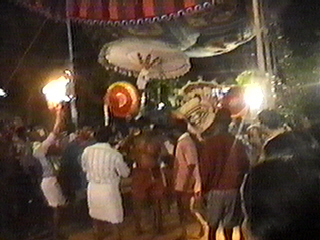Vishnu's
worship of Somaskanda forms the core of the
belief systems surrounding the Ajapaa Natanam.
It is believed that Vishnu fashioned an image of Somaskanda
and wore the image on his chest and meditated upon it in silence.
The meditative silence of the un-uttered
prayer (A - Japaa), accompanied by the graceful movement in both
the vertical and the horizontal planes of the Somaskanda image, in synchronization with
Vishnu's meditative breath is considered to be the root of the mystical Ajapaa
Natanam.
The Ajapa dance of Tyagaraja signifies the
control and manuovere of breathing. The Tevaram hymns of Tirunaavukkarasar
refer to this association between the meditative breath of Vishnu and the
dance of Somaskanda. Tirumoolar's
Tirumantiram speaks of the significance of the unchanted
Ajapa and its association with the dance of Shiva
(Tirukkoothu).
The Somaskanda or Tyagaraja shrine at Tiruvarur is thus associated with the Ajapaa
dance. This dance is enacted everytime the deity is taken out in procession (as in Maargazhi Tiruvadirai and Panguni
Utthiram) - using a contraption held in place with the bark of the plantain tree.

It is to be noted that each of the 7 Saptavitanka
temples is associated with a certain type of dance that is enacted on festive
occasions and that the Tyagaraja shrines in the non-Vitanka stalams such
as Tiruvotriyur and Tiruvanmyur
also feature a form of dance specific to the temple. (Shown above is an image of the
enactment of the 18 Natanam at Tiruvanmyur).
It is also to be noted that the art of classical dance has a special place in the
traditions of the Tiruvarur temple. A
large number of dancers were associated (dedicated to the) with this temple during the
reign of the Imperial Cholas as seen from temple inscriptions in the
Chola region. Dance has been an integral part of the temple worship services although it
does not enjoy the same status now as it did owing to societal changes. Instead, a
distinct pause in the midst of the worship rituals signifies the original status of this
performing art in this ancient monument.
Also see:
Tyagaraja at Tiruvarur
Saptavitanka Stalams
The Somaskanda Legend
Somaskanda Iconography
